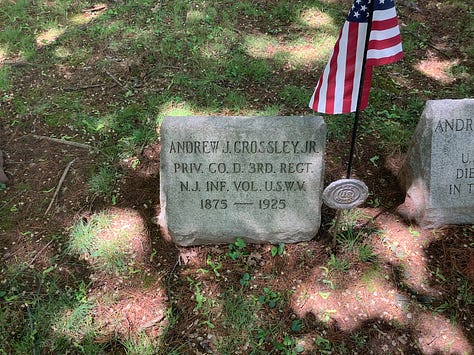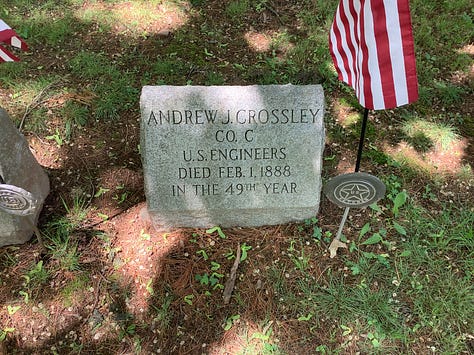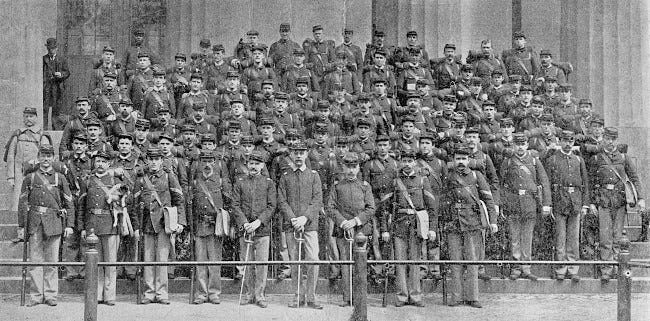This Saturday, May 17, Armed Forces Day, Elmwood Cemetery will be holding events honoring our veterans all day. First, at 12:00 pm, we will be hosting our tour New Brunswick's Forgotten Heroes: Stories of the Spanish American War, which highlights our Spanish American War Veterans. Next, at 1:00 pm we will be holding our annual flag replacement, where we replace our veterans flags ahead of Memorial Day. Finally, at 2:00 pm, we will be hosting our tour No Longer Forgotten: Those Who Served in the Korean War, honoring those who served during the Korean War. Today I wanted to highlight one of our Spanish war veterans, Andrew Crossley Jr.. Mr. Crossley Jr. is the son of Andrew Crossley Sr., who served during the Civil War. This relationship between Civil War veterans and Spanish War Veterans is very complicated and it is definitely worth delving into.
Andrew Crossley served in Company D of the Third New Jersey Infantry Regiment. The vast majority of Elmwood Cemetery’s identified Spanish-American War veterans served in Company D. The Third New Jersey Infantry Regiment would be organized and mustered into service at Sea Girt, NJ between May 11 and May 13, 1898 with 51 officers and 979 enlisted men. Company D would head to Fort Hancock at Sandy Hook, NJ on May 25 where they would remain until August 3, when they headed to Pompton Lakes, NJ.
The Third Regiment was considered by some to be cursed with bad luck. At Sea Girt, while the Regiment was being mustered, it rained continuously for nine days. On June 14, Sergeant W.C. Wiseman of Company H was the first member of the volunteer forces to be court-martialed for falling asleep while on guard duty. Companies C and K would be sent to Fort Wadsworth in NY on July 12, bringing with them rain when they arrived. It apparently rained so violently that the troop’s tents were knocked down.
That same day, William H. Emmons of Company L would be severely injured in an explosion. Companies B, F I, and L were charged with guarding Laflin-Rand Powder Works, which produced the highly explosive gun cotton. Eleven workers would be killed in the accident, and as rescue efforts were being attempted the soldiers would be ordered to fix bayonets to keep families of the workers from putting themselves in danger, as there were fears that more explosions could occur.
Upon Company D’s arrival at Pompton Lakes more rains would follow, soaking through the soldier’s tents. Companies C and K would be the final companies of the regiment to be assigned to Pompton Lakes, with the entire regiment reconvening on September 22. In October the entire regiment acted as an honor guard escorting the body of Brevet Brig. Gen. Charles A. Wikoff in Easton, PA to the cemetery where he was to be buried. It rained the entire march and funeral.
The Regiment would leave Pompton Lakes on November 12 and would arrive at Athens, Georgia on November 13. The Regiment would be assigned to the First Brigade of the Third Division of the Second Army Corps. Upon their arrival at Athens it would begin to rain. It was joked by soldiers and the local newspapers that it would probably not stop raining in Georgia until the 3rd New Jersey left.
With the signing of the Treaty of Paris, the soldiers knew they would be relieved of duty soon. They participated in the Peace Jubilee Parade in Atlanta, Georgia, attended by President McKinley. The regiment would be mustered out on February 11, 1889, with 48 officers and 1,035 enlisted men at that point. The last event for the Third New Jersey Infantry Regiment would occur after this, as 150 members of the regiment in the vicinity of Elizabeth, NJ would be invited to march in a parade in NYC honoring the return of Admiral George Dewey to America in September of 1899.



Andrew Crossley would return to New Brunswick after his service. I find his stone, placed right next to his father’s, to be so interesting. It has been said that some Spanish-American War soldiers enlisted to seek the honor and glory that their forebears had received during the Civil War. It is worth noting that many Spanish-American veterans were the sons of Civil War soldiers, such as Andrew Crossley. Of course, the two conflicts were very different. The majority of Army soldiers during the Spanish-American War remained stateside and did not see any action on the battlefield, and the conflict ended much faster, with a much smaller human toll.
Many Civil War Veterans were hesitant to connect their service to those of the Spanish-American war veterans. The Grand Army of the Republic was quick to announce they would not open their ranks to Spanish-American War Veterans, and some members of the organization suggested that Spanish-American war soldiers should not even get to call themselves veterans. Of course, this sentiment was not necessarily widespread. In the South, the Spanish-American War was seen as a chance to prove a renewed loyalty to the United States. Locally, veterans were an organized front.
While the GAR did not open their organization to Spanish-American War Veterans, groups like the United Spanish War Veterans filled that role. In New Brunswick, the Spanish-American War Veterans organization established their local chapter, the Elwood Holland Camp. The group would be celebrated by the Boggs-Janeway Post of the GAR, and events held by the groups would often see each other's members attend. In New Brunswick, a sense of camaraderie was felt by veterans young and old alike.
Sources:
“Andrew Crossley.” The Daily Home News, January 27, 1925. http://newbrunswick.archivalweb.com/imageViewer.php?i=1664193&q=Andrew%20Crossley&s=q%3DAndrew%2BCrossley%26p%3D2%26r%3D1454%26s%3Da%26o%3D60%26ps%3D15.
“Andrew Crossley Buried.” The Daily Home News, January 29, 1925.http://newbrunswick.archivalweb.com/imageViewer.php?i=1664223&q=Andrew%20Crossley&s=q%3DAndrew%2BCrossley%26p%3D2%26r%3D1454%26s%3Da%26o%3D60%26ps%3D15.
Bamford, Tyler. “The Global Impact of the Spanish-American War.” The Sextant, August 14, 2023. https://usnhistory.navylive.dodlive.mil/Recent/Article-View/Article/3491710/the-global-impact-of-the-spanish-american-war/.
Correspondence Relating to the War with Spain. Vol. 1. Washington, DC: Government Printing Office, 1902.
“Crossley.” The Daily Home News, January 28, 1925. http://newbrunswick.archivalweb.com/imageViewer.php?i=1664204&q=Andrew%20Crossley&s=q%3DAndrew%2BCrossley%26p%3D2%26r%3D1454%26s%3Da%26o%3D60%26ps%3D15.
“Installation of Officers.” The Daily Home News, January 14, 1903.http://newbrunswick.archivalweb.com/imageViewer.php?r=702&in=85&d=1&v=r%3D702%26in%3D79%26w%3D980.
Janney, Caroline. “The Impact of the Civil War on the Spanish-American War.” C-SPAN, February 20, 2016. https://www.c-span.org/clip/the-civil-war/the-impact-of-the-civil-war-on-the-spanish-american-war/4681943.
Kepler, James G. “The Roster of the 3rd New Jersey Volunteer Infantry.” The Roster of the 3rd New Jersey Volunteer Infantry. Accessed January 5, 2024. https://www.spanamwar.com/3rdNJroster.
Lawrence, Caroline. “Seeping Sentiment: Lost Cause Ideology During the Spanish-American War by Caroline Lawrence.” Crimson Historical Review IV, no. 2 (Spring 2022): 35–47. https://crimsonhistorical.ua.edu/volume-iv-no-2/.
McSherry, Patrick. “A Brief History of the 3rd New Jersey Volunteer Infantry.” The Spanish American War Centennial Website. Accessed April 15, 2024. https://www.spanamwar.com/3rdnewjersey.html.
Polston, Mike. “Spanish-American War.” Encyclopedia of Arkansas, May 8, 2025. https://encyclopediaofarkansas.net/entries/spanish-american-war-4856/.
Report of the Adjunct-General of the State of New Jersey for the Year Ending October 31, 1898. Somerville, NJ: Unionist-Gazette Association, State Printers, 1899.
“Spanish-American War.” Encyclopædia Britannica, March 29, 2024. https://www.britannica.com/event/Spanish-American-War.
“The Spanish-American War, 1898.” Office of the Historian. Accessed April 12, 2024. https://history.state.gov/milestones/1866-1898/spanish-american-war.
Young, Grace. “Philippine-American War.” Encyclopædia Britannica, March 28, 2025. https://www.britannica.com/event/Philippine-American-War.




